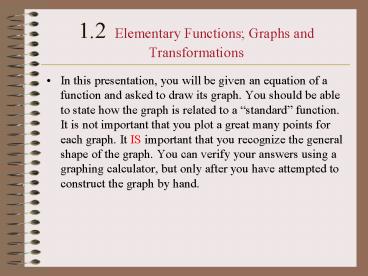1'2Elementary Functions Graphs and Transformations - PowerPoint PPT Presentation
1 / 24
Title:
1'2Elementary Functions Graphs and Transformations
Description:
You should be able to state how the graph is related to a 'standard' function. ... verify your answers using a graphing calculator, but only after you have ... – PowerPoint PPT presentation
Number of Views:63
Avg rating:3.0/5.0
Title: 1'2Elementary Functions Graphs and Transformations
1
1.2 Elementary Functions Graphs and
Transformations
- In this presentation, you will be given an
equation of a function and asked to draw its
graph. You should be able to state how the graph
is related to a standard function. It is not
important that you plot a great many points for
each graph. It IS important that you recognize
the general shape of the graph. You can verify
your answers using a graphing calculator, but
only after you have attempted to construct the
graph by hand.
2
Problem 1
- Construct the graph of
3
Solution
4
Problem 2
- Now, sketch the related graph given by the
equation below and explain, in words, how it is
related to the first function you graphed.
5
Solution Problem 2
- The graph has the same shape as the original
function. The difference is that the original
graph has been translated two units to the right
on the x-axis. Conclusion The graph of the
function f(x-2) is the graph of f(x) shifted
horizontally two units to the right on the
x-axis. - Notice that replacing x by x-2 shifts the graph
horizontally to the right and not the left.
6
Problem 3
- Now, graph the following standard function
Complete the table
7
Solution to problem 3
8
Problem 4
- Now, graph the following related function
9
Solution to problem 4
10
Problem 4 solution
- The graph of
- is obtained from the graph of
- by translating the graph of the original
function up one unit vertically on the positive
y-axis.
11
Problem 5
- Graph
- What is the domain of this function?
12
Solution to problem 5
- The domain is all non-negative real numbers. Here
is the graph
13
Problem 6
- Graph
- Explain, in words, how it compares to problem 5.
14
Problem 6 solution(Notice that the graph lies
entirely within the fourth quadrant)
15
Graph of f(x)
- The graph of the function f(x) is a reflection
of the graph of f(x) across the x-axis. That is,
if the graphs of f(x) and f(x) are folded along
the x-axis, the two graphs would coincide.
16
Cube root function
- Sketch the graph of the cube root function.
Complete the table of ordered pairs
17
(No Transcript)
18
Variation of cube root function
- Sketch the following variation of the cube root
function
19
Same graph as graph of cube root function.
Shifted horizontally to the left one unit.
20
Graph of f(xc) compared to graph of f(x)
- The graph of f(xc) has the same shape as the
graph of f(x) with the exception that the graph
of f(xc) is translated horizontally to the left
c units when c gt0 and is translated horizontally
to the right c units when c lt 0.
21
Absolute Value function
- Now, graph the absolute value function. Be sure
to choose x values that are both positive and
negative as well as zero.
22
Graph of absolute value function
- Notice the symmetry of the graph.
23
Variation of absolute value function
24
Shift absolute value graph to the left one unit
and down two units on the vertical axis.































